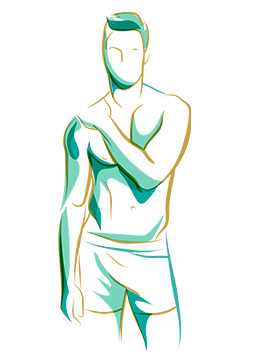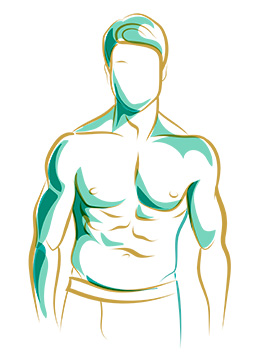BREAST CANCER: DETECTING IT ON TIME, THE KEY TO SAVE LIVES AND ONCE DIAGNOSED, WHAT FOLLOWS
Health promotion and disease prevention are key within the framework of breast cancer awareness month
- It is estimated that 1 in 8 women will have breast cancer throughout their lives, this being the main reason why women should have their breasts evaluated regularly, according to WHO guidelines.
- Breast cancer is the most common cancer and the most common cause of cancer death in women.
- Making changes to our habits and lifestyles could reduce the risk of breast cancer by up to 30%.
- As women, it is our responsibility to know ourselves and perform self-examination on a monthly basis.
Clearing doubts about breast reconstruction
- Breast reconstruction can be done with the patient’s own tissue (pedicled flap, free flap and/or fat), with an implant or by combining both.
- The pedicled flap is taken from neighboring tissue such as the abdomen or back and the free flap is taken from the thigh, gluteus and forearm.
- Since during a mastectomy the tissue and skin of the breast are removed, to reconstruct it, it is necessary to bring skin back to the area, this is achieved with a flap with an island of skin or by placing an expander.
- Expanders stretch the skin of the breast so that an implant can be placed in a second surgery. There are also definitive expanders that we do not have to be changed later for an implant.
- Sometimes radiation therapy is performed before surgery to reduce the size of the tumor and make it easier to remove during surgery.
- It is important to symmetrize the contralateral healthy breast after breast reconstruction to restore harmony beyond the cancer affected breast, giving harmony to the entire cleavage area.
October 19 marks the World Day to Fight Breast Cancer, the most common type of cancer in women. Every year, thousands of new cases are detected in the country. Despite advances in medical care, Colombia faces a growing incidence of this disease, which highlights the need to reinforce promotion, prevention and early diagnosis strategies.
According to the National Cancer Institute (INC), in 2023 more than 15,000 cases of breast cancer were diagnosed in Colombia; and the outlook in the coming years is not very encouraging, as they indicate that this figure will continue to increase in the coming years if more forceful measures are not taken.
Unfortunately, approximately 4,200 women died from this disease, making it one of the main causes of mortality among women.
EARLY DETECTION
Early detection is the key to improving survival rates of the disease, which is why constant monitoring is important.
In cases where breast cancer is diagnosed in early stages, the five-year survival chances can reach 90%. However, in Colombia, more than 40% of cases are detected in advanced stages, which drastically reduces the chances of successful treatment.
This is why during Breast Cancer Awareness Month women are encouraged to take into account the following recommendations:
- Monthly self-examination: Women should perform a breast self-examination every month, preferably at the end of their menstrual period. Knowing your body and detecting any changes early can make a big difference.
- Periodic mammograms: Starting at age 50, it is recommended that women have a mammogram every two years, this allows the identification of tumors in the initial stages and is included in the health benefits plan. For women with a family history of breast cancer, it is advisable to start these tests earlier.
- Healthy lifestyles: Maintaining a balanced diet, exercising regularly, and avoiding excessive alcohol and tobacco consumption can help reduce the risk of breast cancer.
- Care of the area: Just as we have special care for other areas of the body, the breasts should also receive attention and correct daily moisturization.
- Magnetic resonance imaging: It is a useful tool to confirm the diagnosis of breast cancer and better plan breast tumor resection surgery. Furthermore, for those who have breast implants, it is the ideal exam since it not only shows the breast tissue very well but is also the best exam to assess the integrity of the breast implants.
“Although it is scary to know that more women will suffer a breast tumor in their lives than those who will never get it, detecting it quickly means that we have the possibility of treating it on time, where it is still curable. Warning signs could be lumps that were not there before when touching the breast, changes in the color or texture of the skin of the breast and discharge from the nipple. If you see any of these symptoms, go to your doctor immediately. Remember that early diagnosis saves lives! As women, it is our responsibility to know ourselves and perform self-examination on a monthly basis.” says Dr. Lina Triana.
What are the signals or warning signs
Being attentive to the different changes that occur in our body and especially the breasts is vital to identify any unusual signs and symptoms that lead us to consult the doctor and seek appropriate treatment at the right time.
– Masses in the breast or armpit.
– Skin thickening or retractions.
– Change in skin color.
– Recent onset nipple retraction.
– Newly appearing breast asymmetries.
– Ulcerations in the breast or nipple.
– Spontaneous secretions or bleeding from the nipple.
It is important to know that although it may be normal for us to have a cyst (water-filled ball) and/or a fibroadenoma (benign mass or tumor in the breast) at some point in our lives, if they are diagnosed, I should undergo check-ups more frequently.
How is a breast self-exam done correctly?
“The breast self-examination should consist of holding the breast and touching it with the fingertips in the different quadrants in a clockwise direction, identifying the upper medial quadrant, upper lateral, lower lateral, lower medial quadrant and all around the breast, ending on the nipple. It is something simple that does not take long. My invitation is to make it part of your life routine, for example, make it something automatic that you do during the shower. For those who still have the period, do it once it ends, and for those who are already in the menopause stage, choose a regular date every month. Empower yourself with your health, take action and put these simple tips into practice. You are responsible for your breast health!” Indicates Dr. Triana
Is there any way to help me prevent breast cancer?
There are some habits or lifestyles that, if modified, could reduce the incidence. These are: Lead a healthy lifestyle, practice some type of physical activity and maintain an appropriate weight. Excess fat increases estrogen levels in our body and many breast cancers feed on estrogen. Avoiding excessive consumption of alcoholic beverages and nicotine consumption is also part of a healthy lifestyle, as well as a balanced diet and working to reduce stress. By making these changes in our habits and lifestyles we could reduce the risk of breast cancer by up to 30%.” According to the Ministry of Health and Social Protection.
AFTER I AM DIAGNOSED WITH BREAST CANCER, WHAT OPTIONS DO I HAVE TO RECONSTRUCT MY BREAST?
Factors such as how large the tumor is, what type and how aggressive, and whether or not it has spread to other areas, will vary the treatment and with it the reconstruction options.
After the diagnosis of cancer, what follows is how the tumor will be removed. For this you will have an appointment with the oncologist/mastologist surgeon who is the one who removes the tumor and then with the plastic surgeon to consider options for breast reconstruction. Another specialist who is part of the management of the patient with breast cancer is the oncologist, who guides when, what type, and whether or not radiotherapy or chemotherapy is needed. It may even be that radiotherapy or even chemotherapy sessions are first performed with the intention of reducing the size of the tumor and thus facilitating its removal during surgery.
When the cancer is not in an advanced stage and the size is not very large in relation to the size of the breast, a quadrantectomy can be performed. In this type of surgery, a piece of the breast is removed, as if it were a breast reduction. Many times, with this surgery nothing else is needed from a reconstructive point of view. But if what was removed from the affected breast is large, then the breast will look smaller than the healthy breast. In these cases, symmetrization of the healthy contralateral breast with a reduction and pexy, or breast lift, is recommended to achieve harmony in the area. Imagine how you would feel with one breast much larger than the other, how difficult it can be to even wear a bra.
When a mastectomy is performed, all the breast tissue, skin, areola and nipple are removed, for which we must be prepared to leave surgery without our areola and nipple and know that we will have to go through another series of small surgeries to reconstruct them or even tattoo them on the skin or place a silicone areola and nipple implant that is simply placed on top of the skin in the place where our areola and nipple should go. These tattoos and implants are often so well made that you don’t even notice that they are not part of our bodies.
They can also tell us about a skin-saving mastectomy, where they remove all the breast tissue but preserve the breast skin. This option is done, for example, in healthy women without breast cancer or in the healthy contralateral breast after a diagnosis of cancer in the other breast and in who have an increased risk of breast cancer after doing tests that prove that there is a strong genetic influence of getting breast cancer during her lifetime. A skin-sparing mastectomy can also be considered in some cases as the treatment option in the breast that has the tumor. In skin-sparing mastectomies, the empty breast skin must be filled through breast reconstruction and, when the nipple and areola are removed, reconstructed as well.
When a mastectomy is considered, a breast reconstruction is recommended, which will vary depending on how much skin will be removed and how large is the contralateral healthy breast. Not performing breast reconstruction after a mastectomy leaves us with the appearance of having been amputated, something that truly impacts our daily lives. Not having a breast not only impacts how I look in the mirror, but also my daily dressing, how my cleavage looks, the use of a bra and how I project myself as a woman. Let’s remember that the breasts are what differentiates us from the opposite sex and regarding the cleavage, and I am not referring here to a big one, simply the cleavage in general, is important when it comes to dressing. It is not easy to live without a breast.
Breast reconstruction can also be done with implants and/or implants + flap. If it is estimated that if the patient will not need radiotherapy after the surgery where the tumor will be removed, there will be sufficient skin after removing it and the healthy contralateral breast is small, a breast implant could be considered to be placed at the end of the mastetectomy and as a part of that same surgery.
When after a mastectomy we do not have enough skin to fit a breast implant or if radiotherapy is needed after the surgery where the tumor was removed, it is recommended to place an expander. An expander is like an empty breast implant, like an empty water balloon, which your surgeon will inflate little by little after surgery.
How an expander expands: by filling it with water with a syringe through your skin. The expander is generally a temporary step, which requires replacing the expander with a breast implant. There are also some expanders that can be used permanently. A definitive expander is one that I do not have to change later for a breast implant. It is important, however, to discuss the pros and cons of using an expander and having to replace it for an implant in another surgery vs using a definitive type of expander.
The expander is used to stretch the skin of the breast where a breast implant and/or tissue, what we call a flap, will be placed in the future. Fat is also another option in breast reconstruction. Normally the fat is placed accompanied by a flap or breast implant and in some cases, it can also be used as the only reconstruction method.
When talking about symmetrization, or surgery of the healthy contralateral breast, the one that does not have the tumor, it can be done during mastectomy surgery or in a subsequent surgery. Symmetrization surgery is of great help in restoring harmony to the woman’s chest and cleavage, which is why it is highly recommended. It is important to discuss it with the doctor and not only see if it is a possibility, but when during your reconstructive process is best to be performed.
After a woman has been diagnosed with breast cancer, it is always recommended to discuss the options of undergoing reconstruction with her treating doctor. The goal of breast reconstruction is to restore shape to the breast. This reconstruction can be done using the patient’s own tissues and/or breast implants and may or may not be accompanied by symmetrization of the contralateral breast. What type of reconstruction is done will depend on each individual case.
“And as if discovering that we have breast cancer is not enough, we add how will I feel without my breast, what my experience of losing my breast will be like, and how I will project myself as a woman. During the tumor resection process, the anatomy and natural harmony are lost, and breast reconstruction attempts to restore them. However, it is important that we have real expectations after the reconstruction. Asymmetries, scars, changes in touch, in how my breast feels and in the natural appearance of the breast and the cleavage area in general, are not uncommon in reconstructive surgery. Although we will never be able to recreate a breast exactly the same to the one we had before the cancer removal surgery, seeing the patient smile again, flourish and regain her self-esteem are the motivation to continue with our work of enhancing natural beauty, enhancing the inner beauty of our patients.” Says Dr. Lina Triana.
EARLY DETECTION IS IN OUR HANDS
Breast cancer is a disease that, with early detection, can be prevented and successfully treated. It is vital that women in Colombia and around the world become aware and recognize the importance of having regular check-ups and adopting healthy lifestyle habits.
Collaboration between health institutions, civil organizations and society in general is essential to reduce mortality rates from breast cancer in the country. During this awareness month, let us remember that education and prevention are key in saving lives.
[social_share_button]
















